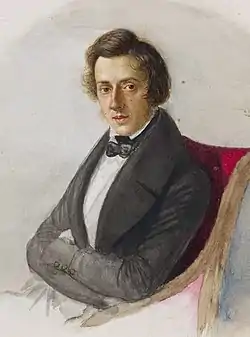Waltzes, Op. 70 (Chopin)
The three Waltzes, Op. 70, were composed by Frédéric Chopin between 1829 and 1842 and were posthumously published by Julian Fontana in 1855, six years after the composer's death. Waltz No. 1 is in G-flat major, No. 2 in F minor and No. 3 in D-flat major.[1][2] Each of the three waltzes lasts less than three minutes to perform in typical performances.[3]


Op. 70, No. 1
The Waltz Op. 70, No.1 in G-flat major was composed in 1832.[4] It is written in the "brilliant style". According to Jeffrey Kallberg, "the unpublished waltzes also capture the joyfulness and glitter of the dance hall and salon, as we can hear in the waltzes in E major, A flat major (Chopin’s only waltz notated in three-eight metre), and, especially, in G flat major, Op 70 No 1."[1][4]

Op. 70, No. 2
.jpg.webp)
The Waltz Op. 70, No. 2 in F minor was composed in 1842.[4] In December 1842 in Paris, Chopin wrote to Anna Caroline Oury about Op. 70, No. 2: "As for the little Waltz which I have had the pleasure of writing for you, please, I beg you, keep it for yourself: I should not like it to be made public."[1] Chopin, however, was fond of offering manuscript copies as gifts to flatter different women dedicatees: in the case of this F minor waltz, there are five different autograph manuscripts.[4]

The Chopin commentator Wilhelm von Lenz wrote that: "Although he never had the Waltzes published, Chopin valued them highly, at least the one in F minor. I often heard him play it, and how incomparably! This nostalgic piece could be entitled Malinconia."[1]
Op. 70, No. 3

The Waltz Op. 70, No. 3 in D-flat major was composed in 1829.[4] As Jeffrey Kallberg explains: "Two of the waltzes offer unusual, personal testimony of Chopin’s amorous sentiments toward women."[4] He continues, "The Waltz in D flat major, Op 70 No 3, dates from Chopin’s Warsaw period, and it indexes his nascent romantic life. In a letter to a friend, Chopin confided that the low melody that begins its trio was inspired by his (alas unrequited) crush on the young singer, Konstancja Gładkowska."[5] Jean-Jacques Eigeldinger gives another account of the same letter, in which Chopin wrote to his friend Tytus Woyciechowski: "In the trio, the bass melody must dominate until the violin's E-flat in the fifth bar

but I don't need to tell you, because you'll feel it anyway."[1] The initial version of the Waltz in A flat major, Op 69 No 1, was intended by Chopin as a present for Maria Wodzińska.[4]
References
- Eigeldinger, Jean-Jacques (1988). Chopin: Pianist and Teacher: As Seen by his Pupils. Cambridge: Cambridge University Press. p. 89. ISBN 978-0-521-36709-7.
- Chopin, Frédéric (1978). Zimmermann, Ewald (ed.). Waltzer. Henle. ISMN 979-0-2018-0131-5: Fingering by Hans-Martin Theopold.
- Cummings, Robert. Waltzes (3) for piano, Op. 70, CT. 217–219 at AllMusic. Retrieved 9 December 2017.
- Hough, Stephen (2011). Kallberg, Jeffrey (ed.). "Frédéric Chopin: The Complete Waltzes,". Hyperion. Retrieved 23 January 2021: Liner notes.
- Hough, Stephen (2019). Kallberg, Jeffrey (ed.). "Frédéric Chopin: The Complete Waltzes,". Hyperion. Retrieved 23 January 2021: Liner notes.
External links
- Waltzes, Op. 70: Scores at the International Music Score Library Project